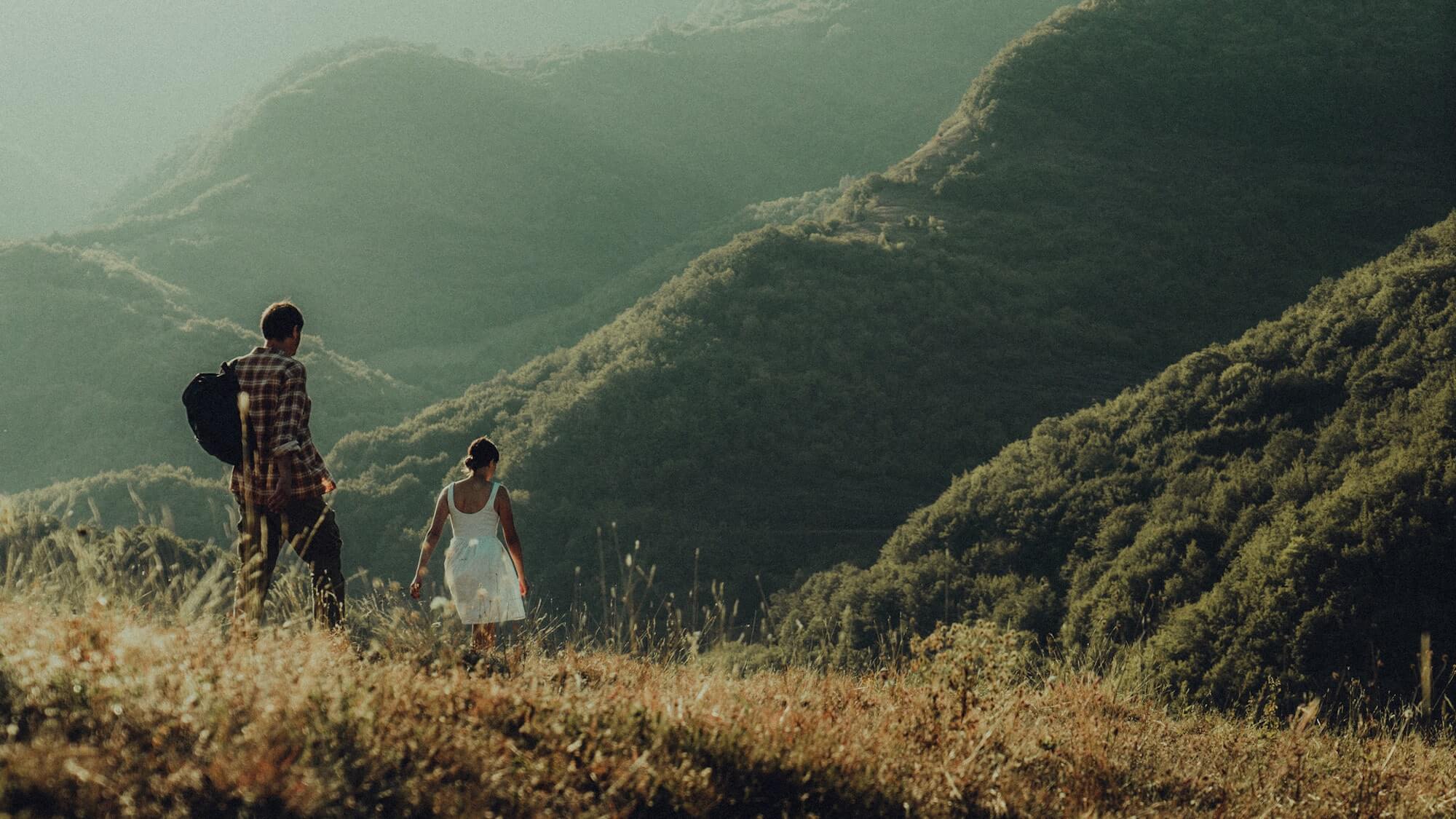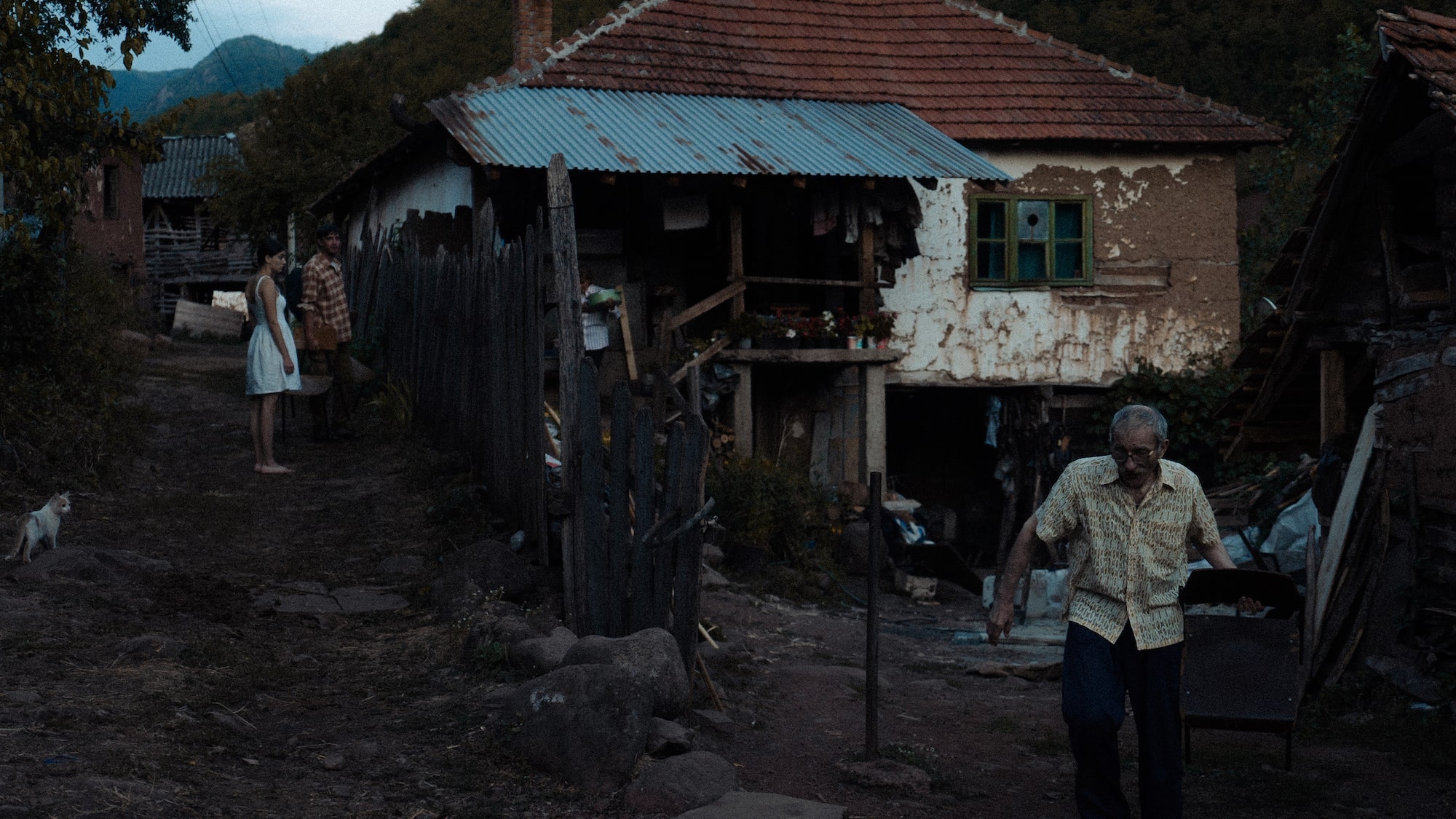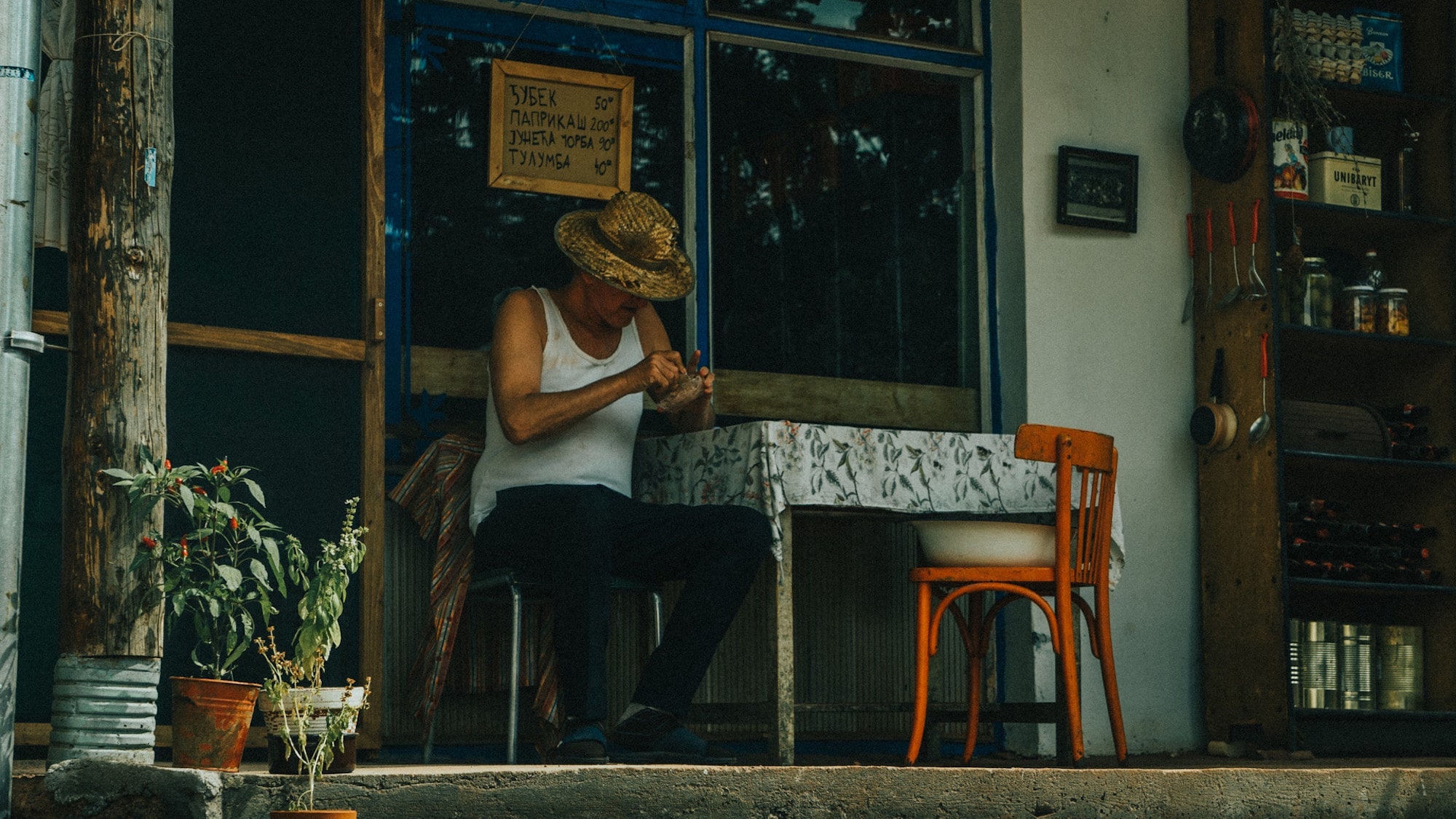
The widescreen lens in Where the Road Leads (Ovuda će proći put) gives its rural characters a feel of the pastoral epic, all the while showing how easily shaped they are by their surroundings. Able to capture the winding roads, looming hills and gorgeous natural beauty of the Serbian countryside, Nina Ognjanović, in her Belgrade Faculty of Dramatic Arts thesis film produced by Pointless Films, creates both a sense of a community and an ever-growing vibe of mystery and danger. Placing absurd situations within a realistic setting, her Slamdance debuting film, playing in the Narrative Feature Competition, highlights a director with a strong authorial sense, as well as a keen eye for small details. Utilising a reverse narrative structure that keeps you guessing right up until the final moments, it’s also a deeply enjoyable experience. We had the pleasure of talking to Ognjanović about working with veteran Serbian actors for her first feature, writing around the landscape, and taking humourous scenes seriously.
It’s a story about small-town mentality and also a mystery, mixing observation with genre elements. What attracted you to this kind of story?
For me, the main focus was always on the protagonist – Jana. Her story and arc. With every choice I made, I had to have previously asked myself if and how it would serve her story. She is a girl who is feeling suffocated in her surroundings without even being aware of it until the new guy comes along. Although that suffocation inevitably comes from within, and could easily happen to someone in a metropolis, a small-town setting was something that made the most sense because, in her head, this place had become the smallest place in the world.
I had written a village that was very specific in its layout that I knew we would never be able to find.
My next focus was how to introduce the audience to such a surrounding. Something that we know very little about is easily registered as mysterious. I wanted to play on that, to introduce the viewer to the village little by little. I wanted to do it through conversations or parts of conversations that they might be able to hear had they really found themselves there. I found that part of the process to be the most fun in those early stages.
I’d love to know more about the location of the film. Was there a lot of location scouting involved in finding the right kind of village?
I had written a village that was very specific in its layout that I knew we would never be able to find. When we set out to scout for locations, I was a little nervous of what we would find; if it would be good enough for me to let go of the preconceived idea that I had in my head. We were extremely lucky that we visited Topli Do on the first day of scouting. We continued scouting for a while after, but quickly it became very clear that all the other villages faded in comparison. Of course, geographically, it was not what I had written, so I had to sit down and rework that part of the script to fit the actual location.
While Belgrade is a lively and exciting city, this slice of Serbia you depict seems a little forgotten and downtrodden. Would you say that there is a big divide between the cities and the countryside in Serbia, both in terms of opportunity and mindset?
In terms of opportunity, I think so. Then again, I don’t think it is a local phenomenon. As for the mindset, I am not so sure. We like to think that people who live in rural areas are rigid and set in their ways far more than those who inhabit cities. That they oppose change at any cost. Personally, I think that all those features exist in humans regardless of their geographical location, that those are inescapable human traits, only in bigger cities they are often overlooked due to the faster pace of life.

The geography of the film, as well as its characters, including the mysterious man who returns to town, suggests to me a western. What kind of genre were you inspired by in the story, and how did you want to approach the way you depicted the characters and their conflicts through the space itself?
I think, at its core, Where the Road Leads is a coming-of-age story. However, as I was working on the film, more and more elements of the story seemed to be leaning towards a western. As soon as I recognised it, I wanted to embrace it and explore where that could take me. I tried not to let myself be constrained by the conventions of the genre, but rather to see what those conventions would look like in a Serbian village. For example, even though we don’t have an official sheriff in our villages, there is unmistakably one person in town who everyone looks to when problems arise. He wears that title even without a badge.
I tried not to let myself be constrained by the conventions of the Western, but rather to see what those conventions would look like in a Serbian village.
What also evoked the western for me was the choice of a widescreen lens. Tell me a little bit about the equipment you used to shoot and how it enhanced your decisions here.
The Western genre had a lot to do with the decision to use a widescreen lens. That was something we consciously did. I wanted to showcase the village and its surroundings. I wanted the viewer to stay aware of where they are, of the wilderness at every point in the film.
For the most part, we used ARRI Alexa Classic because it was available to us and in our price range. The DoP Vladislav Andrejevic and I had shot-listed pretty much every shot on location and we even pre-filmed some of the more complicated ones with our phones to analyse further. As for the rest of the equipment, there was a lot of improvising and compromising on our part, since we had a small budget, but for the most part (because of the careful planning), we managed to pull off what we set out to do. I think we had a dolly for the entire duration of the shooting. However, since the first shot could only be done with a Steadicam, it was crucial that we had it for at least a day. So, we worked that day around the Steadicam. All the shots that required that piece of equipment were scheduled for that day, regardless of the scene or location.

The scenes of Jana running are the heartbeat of the film. Did you think a lot about how to frame her movements here? What was it like pulling some of those tracking shots off?
From the beginning I was aware that there was a risk that those scenes, if not done right, could be boring and repetitive. I spent a lot of time thinking about how to approach them, but at the end of the day, there are only so many ways that you can shoot someone running. I decided to focus on emotion as that is something that inevitably holds your attention. If we’re with her and can recognise what she’s going through, then the scene would be successful. As for everything else, I tried to make a precise shot list of what we needed, but I have to admit that we did go back twice to shoot some additional running shots after we had already started editing.
I wanted the viewer to stay aware of where they are, of the wilderness at every point in the film.
We shot a lot of it from the car, some of it on dolly. The hardest one was the opening shot in the film which was done with Steadicam. I had it in my head, we shot a version of it on our phones, but I knew that it would be challenging when we finally brought all the elements together. And it was. It was raining, the rocks were slippery… At the same time I was aware that it had to be just the right length, that if it lingers for too long it could sink us before the film even begins. There was a lot of planning that went into it, but also a lot of luck.




I loved the non-linear structure, where the first half we’re kind of guessing what may have happened, while the second half tracks back and fills in the gaps. What was the challenge of keeping people invested in the first half, and how did you want to approach the pivotal moment at the end which ties it all together? Did you experiment with any other approaches to the narrative as well?
No, I had written a script that is very close to what the final edit looks like in terms of structure and order of scenes. Like I said, the main thing for me was Jana’s story and her arc, so that last scene made sense from the very start. I had that figured out way before most of the script came together. The reason for that being – that was the moment where she could have changed things, her fate, the New Guy’s fate, and the entire story. Once everything plays out the way it does, that is the moment that she will always go back to in her head. Additionally, I thought that having everything play out the way it does before might give the viewer a false sense that now she knows better because we’ve already seen her in that same situation. I wanted to leave the last shot still for just long enough at the end for that thought to creep its way in, although we know how the story ends.
I like the way that information is often revealed in the middle of something else, for example when the local sheriff-like character is having a shave and learns that the newcomer is under threat. Were you always thinking of how you could tell the story while also absorbing us into village life?
Absolutely. It was important to me to introduce the audience to the village, as it is a big part of the story. I wanted to show what the day-to-day in their lives looks like, but I wanted to stay within a pretty tight time frame. I liked the idea that the first three fragments of the story begin with “it was a day like any other, until…” even though it is all happening at the same time, give or take.

The cast are uniformly excellent. Tell me about the casting process?
The casting process started way before the script was ready and lasted up until the day we went up to the mountains. I had the two leads, Jana Bjelica and Zlatan Vidovic, in mind from the beginning. I was lucky that they had both accepted (and had done so without reading the script) because I didn’t think of any alternatives for those roles. The rest of the ensemble came together piece by piece. At first, I wanted the brothers to be twins, but then I found Ninoslav Culum and Vladimir Maksimovic who were enough alike, yet different enough, and that somehow worked. I always thought of those two roles as a package, so had one of them rejected it, I would probably have had to start looking for both roles again.
I wanted to leave the last shot still for just long enough at the end for that thought to creep its way in, although we know how the story ends.
Igor Filipovic who plays Djura, the self-proclaimed town sheriff, acted in one of my shorts a couple of years before, and I knew that I wanted to work with him again. His part was the most fun to write, partly because Djura is the biggest fool in town, and partly because I was imagining how he would approach it. The tavern hostess is actually one of the professors from school (although, we didn’t take her class).
The process was long because there were a lot of roles to fill, and all those roles required abandoning your life for a while, travelling up to the mountains and doing so based on enthusiasm for a script that would be directed by an unknown 26 year old. Not everyone was open to that.
What was it like working with Eva Ras and Svetozar Cvetkovic, who are both veteran Serbian actors and have worked with legendary Yugoslavian directors such as Dušan Makavejev? Did they impart any wisdom on set?
I won’t lie, in the beginning, I had a little bit of a hard time giving them direction. But Svetozar in particular spent a long time with us up there and soon enough those initial nerves went away. It was impressive watching them and the way that they approached their characters, how subtle yet on point they could be.

With the performances, I got both a sense of naturalism and a little bit of black comedy. What was it like to get these specific kinds of performances out of your cast? What were your directions towards them?
I think the direction that I repeated by far the most was “less”. Because most of the things that are happening in the film could be perceived as over-the-top or improbable, I wanted to give them credibility by treating them as casually as possible. When they were drunk, for example, I asked them to try to hide it. When it comes to humour, I prefer to be subtle. If it’s a joke, I asked them not to treat it as one, because for their characters it was a serious matter.
This is a co-production with the Faculty of Dramatic Arts in Belgrade. Is this a thesis film? How supportive were they during the process?
It is a thesis film. They were very supportive within their means, while at the same time giving us the freedom to figure it out for ourselves. They provided us with some of the equipment, and a couple of crew members, but most importantly they helped with applying for funds from the Serbian Film Center. They also let us postpone everything for a year because we were not sure what turn the pandemic would take.
Where the Road Leads is playing at Slamdance in the USA. What’s it like to be playing at the festival?
It’s nice to be recognised by a festival with a reputation like Slamdance. To be perfectly honest, I don’t know what to expect. I’ve never attended a festival of that calibre in person, let alone screened my film. I think that’s the best answer I can give before it all transpires.
What are you working on next?
I’ve been working on my next script for a while. Hopefully, after the chapter with the festival circuit is over, I can start figuring out how to make it happen.


